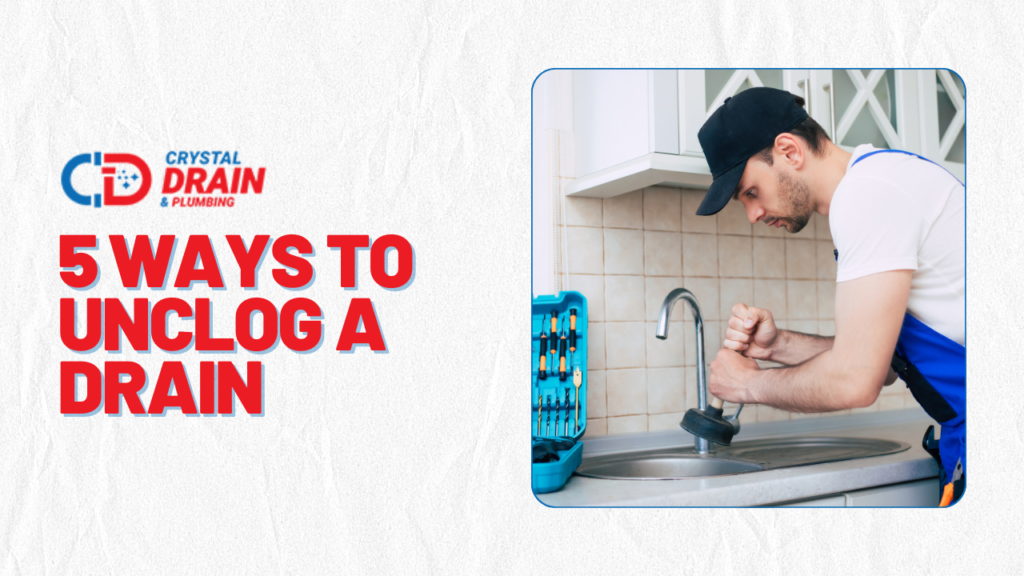5 Simple and Effective Ways to Unclog a Drain

Last Updated: December 6, 2024
Dealing with a clogged drain can be incredibly frustrating, especially when the water refuses to go down. Whether it’s your sink, shower, or toilet, a blocked drain can disrupt your daily routine. Luckily, there are several simple methods to help you tackle the issue before calling in a professional. Here are five effective ways to unclog a drain on your own.
Key Takeaways
- Start Simple: Boiling water is an easy and affordable first step to clear minor clogs.
- DIY Tools Work: A coat hanger can help remove hair and debris from drains without causing damage.
- Natural Remedies: Baking soda and vinegar are great for dissolving grease and grime naturally.
- Dish Detergent for Grease: Dish soap can be highly effective at breaking down grease blockages.
- P-Trap Cleaning: If other methods fail, cleaning the P-trap can often resolve stubborn clogs under the sink
1. Boiling Water: A Quick Fix
This is one of the easiest and most cost-effective solutions for minor clogs.
- How to do it:
- Boil a kettle or pot of water.
- Remove any standing water in the sink with a small mug or cup.
- Carefully pour the boiling water down the drain.
- Wait for several minutes to see if the clog loosens.
If the water still doesn’t drain, you may need to repeat the process or try another method. This simple approach is a great first step to clear up any minor blockages.

2. Using a Coat Hanger to Fish Out Debris
For more stubborn clogs, a wire coat hanger can be a handy tool.
- How to do it:
- Unwind a regular coat hanger, forming a long, straight wire.
- Bend one end into a small hook.
- Insert the hook into the drain and gently pull out any visible debris, such as hair or gunk.
- Be careful not to push debris further into the pipe.
- After you’ve removed the clog, run hot water to clear out any remaining particles.
This method is particularly useful for hair and other soft obstructions that can get stuck in the drain.
3. Baking Soda and Vinegar: A Natural Cleaning Solution
The combination of baking soda and vinegar is not only great for cleaning but also effective for breaking down clogs.
- How to do it:
- Pour ½ cup of baking soda down the drain.
- Follow it with ½ cup of vinegar.
- Let the mixture sit and fizz for at least one hour (or overnight for stubborn clogs).
- Flush the drain with hot water to wash away the loosened debris.
This natural remedy is perfect for eliminating buildup of grease, soap scum, and hair.
4. Dish Detergent for Grease Clogs
If grease or soap is the culprit behind your clog, dish detergent can help break it down.
- How to do it:
- Pour about ¼ cup of dish detergent into the drain.
- Add hot water to help the detergent flow through the pipes and loosen the grease.
- Use a plunger to work the solution into the clog and dislodge any debris.
Dish detergent works as a lubricant, breaking up grease and grime, and making it easier for water to flow freely through the pipes.
5. Clean the P-Trap
If other methods don’t work, the P-trap, the curved section of the pipe under your sink, may be the source of the problem.
- How to do it:
- Place a bucket or bowl beneath the P-trap to catch any water or debris.
- Unscrew the P-trap and carefully remove it.
- Clear out any debris that may be clogging it.
- Reassemble the P-trap and flush the drain with water to ensure it flows freely.
Cleaning the P-trap is an effective way to remove gunk that has built up over time, which can cause blockages.

When to Call a Professional
While these DIY methods work for many common clogs, some issues may require professional attention. If your drain remains clogged despite trying these techniques, or if the problem persists, it may be a sign of a deeper issue within your plumbing system.
FAQs (Frequently Asked Questions)
If boiling water doesn’t work, try using a coat hanger or baking soda and vinegar to break down the clog. If the problem persists, you may need to clean the P-trap or call a professional plumber.
For the best results, let the baking soda and vinegar mixture sit for at least one hour. If possible, leave it overnight, then flush with hot water.
Dish detergent is particularly effective for grease clogs, but it can also help with soap scum and minor blockages. For other types of clogs, you may need a different method.
The P-trap is the curved section of pipe under your sink. It’s a common spot for debris to accumulate. To clean it, place a bucket underneath to catch any water, unscrew the trap, clear out the debris, and reassemble it.
If these DIY methods don’t work, or if you experience frequent clogs, it’s best to consult a professional plumber. There may be a deeper issue with your plumbing system that needs expert attention.
